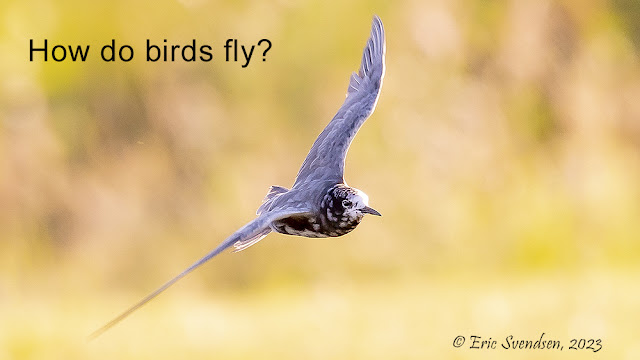How do birds fly?
Man has always looked up to the sky and marvelled at the flight of birds. Their ability to take to the wing, to loftily apply their gift and cruise above ground, unmolested by things bound to the Earth, has been inspiring. As early as 850 BC, King Bladud allegedly made wings, he fell to his death after launching from a great height. You can read about him and other early failed attempts on the How Stuff Works page by clicking here.
One of the key factors missing in understanding flight has been the need for a high surface-area-to-weight ratio. If you were to pick up a domestic rat and a bird of the same relative size, say a robin, you would be amazed at how light one is relative to the other. Birds have hollow bones and numerous air sacks that reduce body mass. I have had to capture swallows to move them outdoors; their weight was negligible in my hands. I caught an injured robin once; it too was seemingly weightless. Google tells me an American robin weighs 77 grams. That's only about two and a half ounces.
The second thing that birds have going for them are wings and a tail covered with feathers. Feathers in themselves are astonishing structures. The primary feathers increase the surface area of the wing significantly at a very low cost to weight. Feathers are complex structures made of the protein keratin, the same stuff that makes our hair and fingernails. The shaft is itself hollow and the radiating barbs interconnect to produce a large surface area. Birds preen to both realign those interconnections and to coat the feathers with oil to waterproof them.
Then there is the arrowdynamic shape of their bodies. The thin beak breaks through the air as the conical shape of the head follows in flight. The rest of the body is streamlined and ends with the tail, the amount of drag being produced minimalized by the tapering. The tail itself fans out to provide lift, braking, and maneuvering abilities.
The wings and tail have a mildly curved upper surface with a flat or mildly curved concave lower surface. Air moves faster under the wing than over the wing producing lift. Strong muscles in the breast also provide lift when the wing is beat in a downward motion. The joint at the elbow allows the wings to fold up upon ascention which reduces the downward force. A repeated series of flaps allows the bird to gain both altitude and speed; the speed means increased lift from the wing shape and the bird can remain airborne with less flapping effort and use the flapping motion to generate speed instead. On gusty days and with rising hot air (called thermals), many birds can remain airborne by simply keeping their wings outstretched. We refer to this as soaring.
All tolled, birds have remarkable physical features and physiological adaptations that have given them the power of flight. In case you are interested, there is an excellent website that has illustrations and further explanations here.
Thanks for reading.
Eric Svendsen www.ericspix.com




Comments
Post a Comment